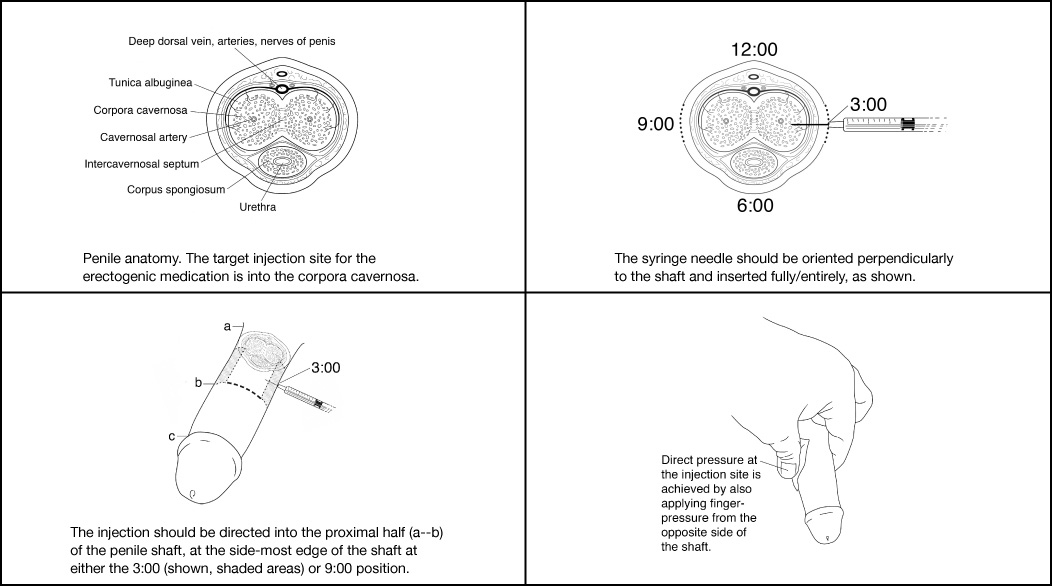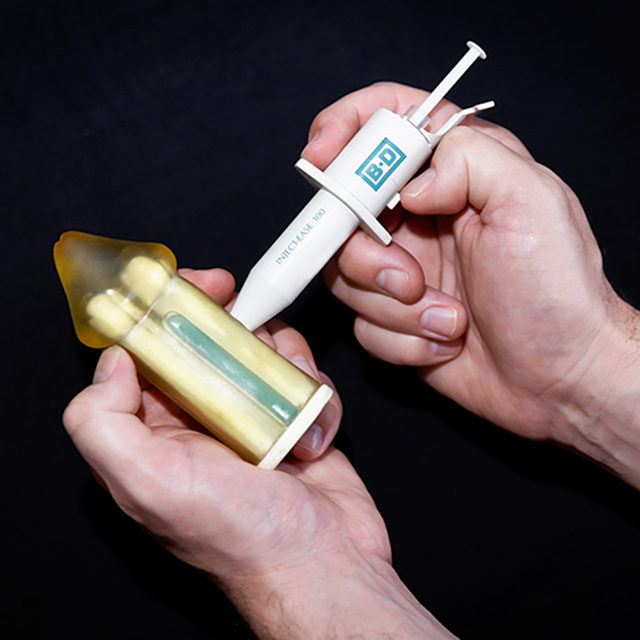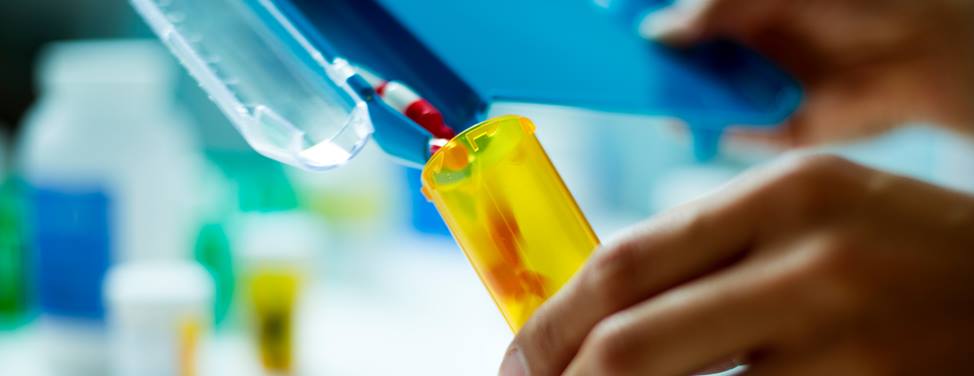
Penile Injections: A Patient Guide
Although you probably find the idea of injecting something into your penis unappealing, many men are highly satisfied with this therapy and will testify to the ease and effectiveness of the injections. Before using the therapy on your own at home, your doctor will show you how to inject the medication. Improper injection and any subsequent scarring can lead to penile curvature and nodules in the penis, so it is important to get proper training before beginning injection therapy.
How medication is injected
The medication is injected along either lateral side of the penis. First, the medication is drawn into a syringe, usually an insulin-type syringe with a short, very fine needle. The medication is given into the spongy tissue of the penis, called the corpora cavernosa.
After choosing the proper site to inject on your penis, clean it with an alcohol wipe, "poke" the needle through the skin of the penis, and then inject the medication into the penis. Immediately afterwards, press firmly on the injection site with either an alcohol pad or gauze with your thumb and first finger to compress the area for at least five minutes or up to 10 minutes for patients taking blood thinning medication, such as coumadin.
The medication tends to work better if you stand, as it allows more blood to go to your penis. Also, external stimulation to the penis increases blood flow to the penis and allows the medication to take effect faster.
Some people prefer the auto-injector, which is a spring-loaded device that inserts the needle into the penis very quickly, minimizing discomfort and psychological "hesitancy." It comes in two forms: a simple, non-prescription device designed to insert the needle for you, and a prescription device that also depresses the plunger for you.
Check with your local drug store for the non-prescription simple auto-injector. Many men prefer the auto-injector that does not inject the medications for them, because they maintain the necessary feel to know that they have injected in the right place and to the right depth.
Side effects
Occasionally, penile injections can cause fainting, dizziness and low blood pressure. In rare instances, priapism or prolonged erections can occur. Patients who are not trained properly may experience pain, infection, bruising and scarring.
Things to remember
- After inserting medication, self-stimulation may be necessary to increase blood flow to your penis.
- If your erection persists for more than four hours, seek medical care at a local emergency room or from your urologist.
- Penile injections may be ineffective in patients who have vascular disease or blood flow problems.
General FAQs
Do penile injections work for everyone?
If the medication is dosed and injected properly, most men will experience an erection response to injections. Finding a dose that works typically requires making adjustments early on. Some men, however, don't respond even to high doses.
Are there medical conditions that preclude using penile injections?
Injections aren't an option for men with any of the following:
- Severe scarring of the penis
- Active infection or sores on the penis
- Allergies to the medications used for injection
Men who are allergic to one of the medication options may be able to use an injection agent that doesn't contain the allergen.
Can I use injections if I take a blood-thinning medication, such as aspirin, clopidogrel (Plavix) or warfarin?
Yes. While blood thinners increase the risk of bleeding and bruising, the needles used for penile injections are small. The risk is minimal so long as you apply pressure on the site immediately after giving yourself an injection.
If I have a condition that causes blood flow problems, such as diabetes, would injection therapy help with erections?
Injections are a powerful treatment but don't work for everyone. Men who have severe or long-standing diabetes have less chance of success with injections. The only way to find out, however, is to try them.
After a nerve-sparing prostatectomy, will injections help me recover natural erections?
Some experts believe that inducing erection responses – a process that injections support – can help preserve or restore natural erections. Though that remains a theory, there's little risk in trying, as long as you do the injections correctly. (Regardless of their value in penile rehabilitation, erectile dysfunction medications can help patients achieve erections for sexual activity after prostate cancer treatment.)
What's the optimal time after prostatectomy to begin injection therapy?
There's no strict criteria for when to start. Most men should take at least four to six weeks to recover from the operation before resuming sexual activity, including use of penile injections.
Will injections work on men who had non-nerve-sparing prostatectomies?
One advantage of injections is that they bypass the nerves that induce erections under normal circumstances. For this reason, injections usually work regardless of nerve-sparing status.
Are the recommendations for using penile injections different when erectile dysfunction (ED) results from radiation therapy, as opposed to other causes?
No, the recommendations are the same.
Can injections be used with vacuum erection devices, or penis pumps?
It is neither necessary nor advisable to use a vacuum device in conjunction with injections. The risk of bruising or bleeding increases if you apply a vacuum device.
I was told not to do more than two injections a week. What's the reason I can't inject every day, for example?
The risk of scar tissue rises with each injection. We don't fully understand this process, but hypothetically, frequent injections increase the risk of scar tissue buildup. Some experts therefore recommend avoiding "overly frequent" dosing. What that means is subject to interpretation, so you should discuss this safety concern with your doctor.
If an injection doesn't start working in 15 minutes, can I try another injection?
No. Repeat dosing isn't recommended because it can cause priapism, a prolonged erection that's potentially dangerous.
Medication FAQs
What medications are used for injections? What are their differences?
There are several medications that can work to help you achieve erections. You and your doctor should discuss which is likely to be best for you. The drugs and drug combinations currently in use include the following:
- Papaverine is available at a relatively low cost and is stable at room temperature, but it's less effective than the other options and may be more likely to cause scarring (fibrosis).
- Papaverine plus phentolamine (Bi-Mix) is more potent than papaverine alone, but with the same potential side effects, such as priapism and scar tissue formation.
- Alprostadil rarely causes priapism, but it may cause pain. (Alprostadil is also known as prostaglandin E1. In powdered form, it may be called CaverJect or Edex.)
- Papaverine plus phentolamine plus alprostadil (Tri-Mix) is the most potent option. It requires refrigeration and has the same side effects as papaverine and alprostadil.
- Quad-Mix, a combination of Tri-Mix and a drug called atropine, is another formulation, but it's not often used, as the role of atropine in the erection process is unclear.
If you're using injections but having problems achieving adequate erections, talk to your health care provider about changing the medication, the amount you inject or the strength of the solution.
How do these medications work to produce an erection?
The drugs lead to an erection by relaxing the smooth muscles and widening the blood vessels in the penis, enhancing blood flow. They don't depend on nerve stimulation. A more complete description of how the penis functions can be found in our discussion of erectile dysfunction.
How is the correct dosage determined? How do I know when I'm on the right dose?
Dosage involves the medication's strength and the amount used. With the appropriate strength and amount (usually less than 1 cc), as determined by a doctor, erections usually occur in five to 10 minutes and last approximately 30 minutes to an hour. The erection becomes more rigid if sexual stimulation occurs. It may take some time and experimentation to determine your optimal medication and dose.
Will I develop a tolerance over time and require an increasing dose?
You won't develop a tolerance, but since ED is progressive, dose adjustments over time are sometimes necessary, particularly for men who use injections for many years. You may be able to reduce the need for this by compressing the site after injecting, switching up your injection placement and spacing out your injections.
My medication requires refrigeration. How long can it be left out?
The issue isn't that the medication will spoil and become dangerous, as with food left out of the refrigerator. But these drugs gradually lose potency, a process that accelerates if they're not kept cold. So try to put your medication back in the fridge promptly.
Can I use the medication directly from the refrigerator?
Yes, so long as it's completely thawed (not frozen).
Are there medications not requiring refrigeration that I can use while traveling?
Some medications are available in powdered form to be mixed at the time of use. Examples include alprostadil (CaverJect or Edex) and some formulations of Tri-Mix. Mixed compounded medications can be transported but ideally should be kept in checked bags or a cooler, so they stay as cold as possible and retain potency.
Do these medications lose potency over time even if stored correctly?
Yes, over several months they become less effective. Compounding pharmacies are required to note expiration dates for their products. The medication won't become dangerous to use after expiration but may be less effective.
Are there long-term side effects to the use of injections?
There is a small risk that injections or medications used can cause or reveal scarring in the penis. This can lead to Peyronie's disease, a painful deformity of the penis caused by a build-up of plaque or scar tissue in the erectile tissue (the corpus cavernosa). However, Peyronie's Disease is relatively rare and can be treated. You can minimize the risk of developing Peyronie's disease by using correct injection technique.
Are there medications that reduce the risk of Peyronie's disease?
No medical therapies are shown to reduce the risk of developing Peyronie's disease. Some experts recommend using certain drugs (such as pentoxifylline, which improves blood circulation), but we don't have robust evidence that these drugs work for this purpose.
Can compressing the injection site reduce the chance of Peyronie's?
Compressing the site to prevent bleeding may reduce the chance of developing scar tissue.
Injection FAQs
How can I easily withdraw the medication from the upside-down glass vial?
Before piercing the rubber top of the vial, pull back on the syringe plunger to draw in a volume of air roughly equivalent to the amount of fluid you plan to inject. Keeping this air in the syringe, push the needle through the rubber stopper on the medication vial. Holding the vial upside-down, press the plunger to push the air into the vial before withdrawing the medication dose.
Where in the penis should the medication go? What structures do I aim for and which do I avoid?
You need to inject into the corpora cavernosa (columns of spongy erectile tissue running the length of the penis). Alternate between injecting at 3 o'clock and 9 o'clock positions at the middle of the shaft. Avoid any area where a blood vessel is visible, and don't inject the same spot every time.
Besides the 3 and 9 o'clock positions, I've been told that I can inject at 2, 4, 8 and 10 o'clock. Does it matter?
These alternative positions are OK, but there's a greater risk that the needle won't go into the erectile tissues, leading to a failed injection.
How can I be sure I'm injecting in the right place?
The key is to ensure that the needle gets into the corpora cavernosa. This is best accomplished by inserting the needle perpendicular to the penis shaft. You may note a small amount of resistance as the needle penetrates your skin and again when it penetrates the tunica albuginea (the tough sheath covering the erectile tissue). If the needle is properly placed, it shouldn't be difficult to push down on the plunger. If you meet resistance, the needle tip may be in a tough layer of fascia; in this case, back up the needle slightly and try again.
At what angle should the needle enter the penis?
Approximately 90 degrees. As long as the injection is perpendicular to the shaft of the penis, the risk of urethral injury is low. If the injection is too shallow, the medication may not get into the corpora cavernosa and may not work.
What's the best way to hold the penis for injections?
In general, it's easier to inject into the right spot if the head (glans) of the penis is grasped and pulled away from the body to full extension. This technique thins the skin and makes the corpora cavernosa easier to target.
What needle length should I use?
A 1⁄2-inch or 5/16-inch needle is appropriate for injecting a penis of any size or shape.
Does the injection hurt?
As there are few nerve endings on the penile shaft, most men feel no pain or only mild, brief discomfort. Injections with medications that contain prostaglandin may cause an aching sensation.
If the injection hurts, can I use a topical anesthetic?
Yes, any local anesthetic, such as a lidocaine jelly or cream, will help. Emla, a combination of 2.5% lidocaine and 2.5% prilocaine, is available with a prescription. ELA-Max, which is 4% or 5% lidocaine, is available without a prescription.
Are there thinner needles that could be used to reduce discomfort?
That's not recommended. Smaller needles are prone to breaking. The typical width of the needle for these injections is 28 to 30 gauge.
What's an auto-injector and how does it help with injections?
An auto-injector is a spring-loaded device that inserts the needle very quickly, minimizing that moment of hesitation that people commonly have when injecting a sensitive area. It comes in two forms: a nonprescription device that simply inserts the needle and a prescription device that also depresses the plunger. Check your local drugstore to get the simple auto-injector without a prescription.
Using an auto-injector makes sense for men who balk at inserting a needle into their penis or worry about not hitting the right spot. Whether the device results in less pain is unclear; some men report that using the spring-loaded device hurts more than a regular self-injection.
How do I use the auto-injector?
Fill the syringe as usual, then load it into the auto-injector. Clean one side of your penis with an alcohol swab, place the injector against the site where you want to inject, and press the button that activates the injector. The needle will be automatically inserted.
Can I use a needle-free injection system, such as the type used by people who take insulin for diabetes?
No, these systems place medications in the skin. The ED medication needs to reach deeper tissues.
Why do I sometimes see a tiny amount of blood at the injection site just after withdrawing the needle?
Slight bleeding may result from injury to a small blood vessel. It is not cause for concern and can be managed by applying pressure to the site.
Is it important to compress the injection site for a full five minutes after an injection?
Five minutes is ideal. In most cases, less time does the job, but men who have a tendency to bleed or take blood thinners should try to compress the puncture site for the full five minutes.
Should I vary the injection site, and if so, how?
The options for placing an injection are limited by the anatomy of the penis, but alternating sites between the left and right sides is a good practice.
Placing injections is easier for me on one side of my penis than the other. Is it essential to alternate sides?
It is better to use both sides. If you can't, using just one side is OK. The risk of scarring on that side is minimal unless you're injecting multiple times a week.
Is it important to get all the air bubbles out of the medication in the syringe before injecting?
A few tiny bubbles are not going to harm you. Do your best to eliminate them by flicking the side of the syringe, but don't worry about clearing every last bubble.
Erection FAQs
How long do the erections last?
This depends on a number of factors, including your general health, current physical state, whether you injected the proper dosage and the presence of sexual stimulation. Erections generally appear five to 10 minutes after injection and last about 30 minutes, though the duration can be longer. An erection that lasts more than four hours may become painful and require medical treatment to prevent tissue damage. The goal with injections should be to produce erections that last no longer than is necessary for a satisfying sexual experience – so when you find the right dose, you should stick with it.
Is sexual stimulation required for an erection? Can I use less medication if I have more stimulation?
Stimulation is not required after penile injections but may enhance erectile response. You may be able to use less medication if you combine it with stimulation. Bear in mind too, that you don't need to have an erection to achieve an orgasm. Using a vibrator or modifying your sexual practices can help in having satisfying sexual encounters even without an erection.
If I want the erection to last longer but I don't want to use more medication, may I use a penile constriction ring?
Yes, but never keep the ring in place for more than 30 minutes at a time.
Sometimes a dose that previously worked fine produces no erection. What happened?
The most likely explanation is either that the injection failed to reach the corpora cavernosa or that the medication has expired and lost effectiveness. It's also possible that your ED has worsened and you need a higher dose or different formulation.
If I don't get an erection after injecting, can I follow up with another injection – maybe to a different side of the penis and using a smaller dose?
Repeat dosing is risky, as it may increase the risk of priapism. Sometimes you just need to wait a bit longer for the medication to take effect. If there's definitely no response, your safest bet is to accept that the injection didn't work this time and wait at least 24 hours before trying again.
What is priapism, and why is it dangerous?
Priapism is a prolonged erection not associated with sexual excitement. Most cases are of the ischemic variety – blood is trapped in the penis, unable to flow out through the veins. Priapism resulting from injections is virtually always ischemic. If ignored, priapism may result in severe pain and permanent erectile dysfunction not responsive to medical therapy. Fortunately, it can be reversed if treated promptly. Contact your doctor or go to the emergency room immediately if you have a rigid erection that lasts more than four hours.
Can I try using ice packs, exercise, and allergy or asthma medications – such as Sudafed, Benadryl or terbutaline – to reduce a prolonged erection?
None of these treatments are reliable methods for reversing priapism. If you think you might have priapism, don't delay in calling your doctor or getting to an ER.
Treatment complication FAQs
Can penile injections cause lasting damage to the penis?
Although it's rare, scarring is possible. To reduce the risk, follow your doctor's advice on using this method and pay careful attention to injection technique.
What should I do if I see bleeding from the tip of my penis after an injection?
Bleeding from the opening of your penis likely indicates puncture of the urethra. This will most likely stop if you apply pressure to the entire penis for five to seven minutes. In the very rare case that the bleeding doesn't stop, you should go to the ER.
What if I accidentally hit a large blood vessel?
Compression will usually stop any bleeding related to needle injury from penile injections. If you're still bleeding after applying direct pressure for 10 to 15 minutes, call your doctor.
Do infections ever develop from injections?
It's very rare.
Does the injection poke make me more susceptible to contracting a sexually transmitted infection (STI)?
The puncture doesn't increase the risk of contracting or transmitting an STI. If you are concerned that you or your partner may have an STI, you should get tested and use a condom for mutual protection.
Can injections be used while taking oral medications for erections?
The risk of priapism increases if you combine injections and oral ED medications. Some men may benefit from this approach, but before trying it, you should ask your doctor whether it would be safe and appropriate for you.
After using injections for a while, my erections have developed a curvature. What's happening?
The injections may have caused scar tissue to form. Curvature occurs in no more than 10% of men in the general population but may be more common in those who use injections. The condition is called Peyronie's disease. Talk to your doctor about causes and treatment.
Can men who develop curvature continue to safely use injections?
If the curvature is minimal and doesn't interfere with sexual experience, they usually can.
Are there treatments for bothersome curvature of the penis?
The only medication for Peyronie's disease approved by the Food and Drug Administration (FDA) is an injection called Xiaflex (collagenase clostridium histolyticum) that can dissolve the scar tissue and help straighten the penis. Surgical correction may also be possible if the curvature is stable and has been present for at least six months. Some oral medications have been used to treat Peyronie's disease, but none has strong evidence of efficacy and none is approved by the FDA.
What medications or procedures are on the horizon to help men with ED?
A variety of novel drug formulations are under investigation. A technique using low-intensity shock waves shows promise, but as of May 2021, this treatment is not a standard of care and should be received only by participating in a clinical trial. Other technologies under study for ED treatment include stem cell therapy, gene therapy, acoustic wave therapy and platelet-rich plasma, but all similarly lack evidence of effectiveness and shouldn't be considered outside of a clinical trial setting. Whether these treatments for ED can be used in men who have been treated for prostate cancer is unclear, since most published studies to date have excluded this population.
This article was written by UCSF medical experts Alan W. Shindel, MD, MAS, and Tom F. Lue, MD, FACS, DSc (honorary), and UCSF patient advocate Stan Rosenfeld. It was last reviewed in May 2022.
This information is for educational purposes only and is not intended to replace the advice of your doctor or other health care provider. We encourage you to discuss any questions or concerns you have with your provider.












